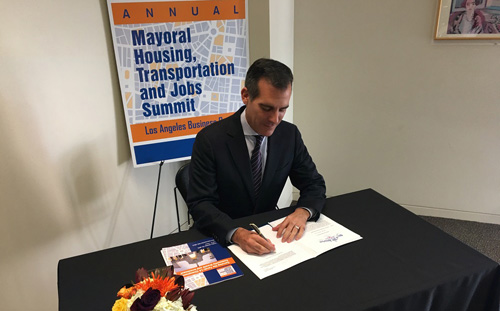What’s the Story on Linkage Fees for Affordable Housing?

Mayor Garcetti at October 2015 Mayoral Summit where he announced his goal of getting linkage fees from developers to finance affordable housing.
Leslie Evans
Los Angeles has the least affordable housing in the United States. It is short some 500,000 units of housing for its population. Rising population, which pushes up land, materials, and labors costs, has made affordable housing in California a mostly unprofitable investment. Cities throughout the state have found themselves facing chronic and deepening housing shortages, with increasingly unaffordable rents. The response has been to look to government subsidies to try to fill the gap.
Some 170 California cities and counties have adopted inclusionary housing ordinances. Most often these take the form of requiring larger new housing developments to include a certain percentage of units with lower rents.
An alternative inclusionary housing model is to place a tax on new commercial and residential developments to fund low-cost housing elsewhere in the city. The tax, based on square footage or by unit, is the linkage fee. Linkage fees are in use now in such cities as San Francisco, Oakland, San Diego, Chicago, and Boston.
A California appellate court upheld inclusionary housing ordinances in 2001 in Home Builders Assn. v. City of Napa. That decision faced years of legal challenge. It was finally ruled legal by the California Supreme Court in June 2015 in California Building Industry Association v. City of San Jose. With the legal issues now clear, Los Angeles Mayor Eric Garcetti in October 2015 called for the City Council to adopt linkage fees for new construction in the city.
Almost a year later, in September 2016, the city’s Housing and Community Investment Department released the Affordable Housing Linkage Fee Study and draft ordinance. The fees would apply to condos, apartment houses and complexes, hotels, restaurants, shops, and business and factory buildings. The rates proposed are at the very low end of the scale: $5 per square foot for new commercial properties, $12 for residential. Residential projects with 5 or fewer units would be charged $1 per square foot.
Lisa Payne, policy director of the Southern California Association of Nonprofit Housing, told Curbed L.A. in February 2017, “If we want a livable city for everyone, we need this fee. We have so many people who can not afford a place to live decently in this city.” She advocated that the residential fee be set at $15 a square foot.
There are a number of exemptions in the proposed ordinance. These include single family homes, residential complexes that will include a certain percentage of affordable housing, and commercial construction of less than 10,000 square feet.
The Los Angeles Times ran a June 17, 2017, editorial supporting the linkage fees: “This is the moment for Los Angeles to finally address the underlying problems in the housing market that have made Los Angeles such an expensive city to live in and allowed the homelessness crisis to grow.” They pointed to whole families living in tiny apartments and converted garages, or commuting hours every day from remote suburbs.
The paper noted that since 2010 there has been a 70% drop in funding for affordable housing, particularly due to the abolition of the state redevelopment agencies, which cost Los Angeles $50 million a year.
The linkage fees are expected to raise about $100 million a year and to pay for construction or rehabilitation of 700 to 1,000 units of affordable housing each year.
Comments
Leave a Reply
You must be logged in to post a comment.



